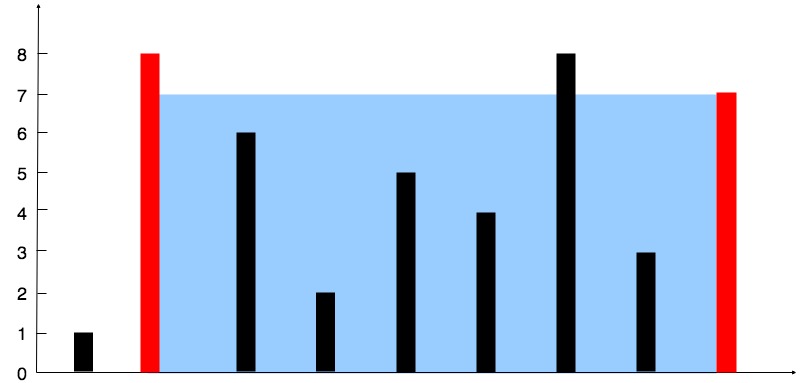You are given n non-negative integers a1, a2, ..., an , where each represents a point at coordinate (i, ai). n vertical lines are drawn such that the two endpoints of line i are (i, ai) and (i, 0). Find two lines, which together with the x-axis form a container, such that this container contains the most water.
Note: You may not slant the container and n is at least 2.

The above vertical lines are represented by the array [1,8,6,2,5,4,8,3,7]. In this case, the max area of water (blue section) one container can contain is 49.
Example:
Input: [1,8,6,2,5,4,8,3,7] Output: 49
The core challenge of this problem is to find two lines that, together with the x-axis, form a container that holds the maximum amount of water. This problem is significant in various fields such as computer graphics, game development, and any scenario where spatial optimization is required.
Potential pitfalls include misunderstanding the constraints (e.g., assuming the lines can be slanted) and not considering all possible pairs of lines.
To solve this problem, we can start with a naive approach and then move to more optimized solutions.
The naive solution involves checking all possible pairs of lines and calculating the area for each pair. This approach is not optimal due to its high time complexity of O(n^2).
A more efficient approach uses the two-pointer technique. We start with two pointers, one at the beginning and one at the end of the array, and move them towards each other. At each step, we calculate the area formed by the lines at the two pointers and update the maximum area if the current area is larger. We then move the pointer pointing to the shorter line inward, as this might help in finding a taller line that could potentially form a larger area.
Here is a step-by-step breakdown of the optimized algorithm:
#include <vector>
#include <algorithm>
#include <iostream>
using namespace std;
// Function to find the maximum area of water that can be contained
int maxArea(vector<int>& height) {
int left = 0; // Initialize left pointer
int right = height.size() - 1; // Initialize right pointer
int max_area = 0; // Initialize max area
// Loop until the two pointers meet
while (left < right) {
// Calculate the area with the current left and right pointers
int width = right - left;
int current_height = min(height[left], height[right]);
int current_area = width * current_height;
// Update max area if the current area is larger
max_area = max(max_area, current_area);
// Move the pointer pointing to the shorter line inward
if (height[left] < height[right]) {
left++;
} else {
right--;
}
}
return max_area; // Return the maximum area found
}
// Main function to test the maxArea function
int main() {
vector<int> height = {1, 8, 6, 2, 5, 4, 8, 3, 7};
cout << "The maximum area of water the container can contain is: " << maxArea(height) << endl;
return 0;
}
The time complexity of the optimized solution is O(n) because we only traverse the array once with the two pointers. The space complexity is O(1) as we are using a constant amount of extra space.
Potential edge cases include:
To test the solution comprehensively, consider the following test cases:
When approaching such problems:
In this blog post, we discussed the "Container with Most Water" problem, explored a naive and an optimized solution, and provided a detailed explanation of the algorithm and its implementation in C++. Understanding and solving such problems is crucial for improving your algorithmic thinking and coding skills.
For further reading and practice, consider the following resources:
Our interactive tutorials and AI-assisted learning will help you master problem-solving skills and teach you the algorithms to know for coding interviews.
Start Coding for FREE